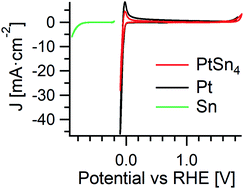Efficient hydrogen evolution reaction with platinum stannide PtSn4via surface oxidation†
Abstract
By means of surface-science experiments, electrochemical tests and density functional theory, we unveil the mechanisms ruling the catalytic activity of PtSn4. Specifically, through an investigation of the surface chemical reactivity toward CO, H2O, and O2 molecules at room temperature and, moreover, of surface stability in air, we show that the catalytic activity of PtSn4 is determined by the atomic tin layer constituting its surface termination. The PtSn4 surface is not affected by CO poisoning, although it evolves into a tin-oxide skin in the ambient atmosphere. We demonstrate that the hydrogen evolution reaction on PtSn4 can be modelled by the combination of two steps, i.e. Volmer and Tafel reactions. Surprisingly, surface oxidation induces a reduction of the energy barrier for the Tafel reaction, so that oxidized PtSn4 behaves similarly to Pt(111), in spite of the reduced amount of Pt in the alloy and without available over-surface Pt sites. Correspondingly, we observe in electrochemical experiments a Tafel slope of 86 mV dec−1 and an onset potential similar to that of pure Pt. However, PtSn4 contains only 29% wt of Pt, with a reduction of the economic cost by 70%. Our results indicate PtSn4 as a promising novel material for electrocatalytic reactions, whose performance could be further tuned by surface treatments.



 Please wait while we load your content...
Please wait while we load your content...